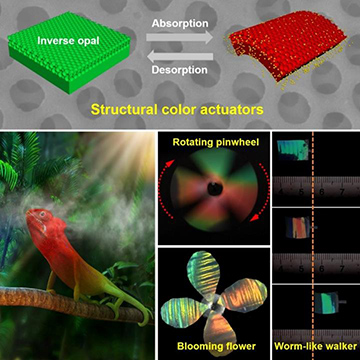Inspired by the chameleon’s color-shifting abilities, a team from the Chinese Academy of Sciences has developed structural-color films that can change color and also move in response to changes in the vapor environment. [Image: Courtesy of Du Xuemin] [Enlarge image]
Researchers in China have devised thin films, inspired by the adaptive iridophores, or nanophotonic structures, of the chameleon’s skin, that respond mechanically and chromatically when exposed to certain vapors (Matter, doi: 10.1016/j.matt.2019.05.012). The researchers believe that the resulting “structural-color actuators” they’ve demonstrated, which can move and change color when confronted with changes in the chemical environment, could find use in “sensing, communication and disguise” for soft robotics.
On the hunt for actuators
Actuators for soft robotics have been an active area of research in recent years—with progress, for example, in polymer-based soft actuators that can enable shape shifting and movement. A variety of systems have attempted to add color to the mix, by incorporating integrated microfluidics to pump dyes into the actuators to allow for color changes and camouflage. But some of these systems have been vulnerable to photobleaching and have had slow response times, making them a less-than-ideal fit for truly adaptive coloration.
The team at the Chinese Academy of Science, led by Xuemin Du, looked to another coloration model: The structural colors used for sexual displays and camouflage in nature, particularly by the chameleon. These lizards have a legendary ability to quickly change color to blend into the surrounding environment—an ability that results partly from guanine nanocrystals embedded in structures called iridophores in the creature’s skin. The nanoparticles behave as photonic crystals; by actively adjusting the spacing between them, the lizards can cause the interference patterns of the scattered light to change as well, resulting in color shifts that can happen nearly instantaneously.
Inverse opal structure
The chameleon has already offered inspiration for a variety of photonic inventions, including one type of plasmonic nanolaser. Du’s team reasoned that the same kind of system could be pressed into service to allow for color changes in soft robotics—and that, with a little tweaking, the nanocrystals could do double duty as mechanical actuators as well.
To get there, the team started by laying down a highly ordered template of silica nanoparticles, created by self-assembly on the surface of a glass slide, and then filled up the air pores between the particles with a precursor solution of a polymer, PTMPTA, that’s known to rapidly absorb and desorb organic vapors. The researchers then cured the polymer using UV light and etched the composite into a 100-μm-thick film.
The resulting film had an “inverse opal” photonic crystal structure, which allowed it, from the get-go, to display brilliant structural colors at characteristic Bragg diffraction peaks. The researchers also found that, because of the polymer’s superb vapor-absorbing abilities, they could make the structural color change by exposing the film to certain organic vapors: the polymer absorbed the vapors, causing the film to swell, the spacing between the lattice of silica nanospheres to change, and thus the structural colors to shift—just as with the chameleon’s skin.
Pinwheel, flower, inchworm
The team was even able to adapt the system into one allowing mechanical as well as chromatic control. To do that, the researchers used a photomask to lay down a micropattern of stripes of another vapor-responsive polymer, PHEMA, atop the inverse-opal film.
By cutting the resulting patterned film at various angles, the researchers were able to create films that not only changed color but also curled, twisted and rolled when exposed to acetone vapors. They even used the system to fashion novelty demos such as a spinning, color-changing pinwheel, a polychromatic, opening-and-closing “flower,” and an inchworm-style self-locomotive walker that changed coloration as it moved.
The study authors believe that the rapid, sub-one-second response and stability of their chameleon-inspired, color-shifting actuator system give it a leg up on some competing systems. Further, while the existing system is actuated by changes in the vapor environment, Du’s team believes that the films could be modified to “become aware of other stimuli,” ranging from light to electric and magnetic fields to pressure—allowing creation of “many different types of robots that can truly sense, respond, and interact with the environment.”

